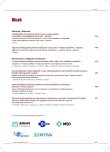Impact of basal prolactin levels on the prevalence of complications and the prognosis of patients with liver cirrhosis
Authors:
T. Koller; J. Kollerová; M. Huorka; T. Hlavatý; J. Payer
Authors‘ workplace:
V. interná klinika Lekárskej fakulty UK a FNsP Bratislava, Slovenská republika, prednosta prof. MUDr. Juraj Payer, CSc.
Published in:
Vnitř Lék 2009; 55(5): 468-473
Category:
Original Contributions
Overview
Introduction:
Prolactin concentration was proved to be associated with complications of cirrhosis.
Methods:
This relationship was investigated on the group of 90 patients predominantly males with alcoholic cirrhosis. Basic clinical and laboratory data were collected at entry as well as complications of cirrhosis already present. Patients were followed for the mean of 434 days and events such as variceal bleeding, hepatorenal syndrome and death were recorded.
Results:
We found that 16.7% of patients had elevated serum prolactin levels, and had significantly higher Child-Pugh and MELD scores as well as higher ascites and encephalopathy stage. By comparing prolactin concentration quartiles we found complications of cirrhosis such as ascites, higher INR, jaundice and higher Child-Pugh and MELD scores more often with increasing prolactin concentrations. The most prominent was the relationship to hepatic encephalopathy (0 vs 31% between the 1st and 4th quartile, p < 0.05) to which the prolactin levels above 10.5 μg/l had a sensitivity of 92.9% and negative predictive value of 97%. Kaplan-Meier survival curve showed that patients in the 1st comparing to the 4th quartile had significantly higher survival rates (85.2 vs 50%, p = 0.046, hazard ratio = 0.2881). Prolactin levels > 11.91 μg/l had 80.8% sensitivity and 87.8% negative predictive value to predict death during the follow up period.
Conclusion:
Basal prolactin concentration could therefore be used as an alternative marker of hepatic encephalopathy and death in a selected subset of patients with cirrhosis.
Key words:
prolactin – cirrhosis – hepatic encephalopathy – survival
Sources
1. DeGroot LJ, Jameson JL. Endocrinology. 5th ed. Philadelphia: Elsevier-Sauders 2005: 309–319.
2. Simon-Holtorf J, Mönig H, Klomp HJ et al. Expression and distribution of prolactin receptor in normal, fibrotic, and cirrhotic human liver. Exp Clin Endocrinol Diabetes 2006; 114: 584–589.
3. Taffetani S, Glaser S, Francis H et al. Prolactin stimulates the proliferation of normal female cholangiocytes by differential regulation of Ca2+-dependent PKC isoforms. BMC Physiol 2007; 7: 6.
4. Soupart A, Buisson L, Prospert F et al. Indirect evidence to suggest that prolactin induces salt retention in cirrhosis. J Hepatol 1994; 21: 347–352.
5. Mukherjee S, Kar M, Dutta S. Observation on serum prolactin in hepatic cirrhosis. J Indian Med Assoc 1991; 89: 307–308.
6. Ardizzi A, Saglietti G, Grugni G et al. Blood prolactin patterns in hepatic cirrhosis. Minerva Med 1994; 85: 511–513.
7. Zietz B, Lock G, Plach B et al. Dysfunction of the hypothalamic-pituitary-glandular axes and relation to Child-Pugh classification in male patients with alcoholic and virus‑related cirrhosis. Eur J Gastroenterol Hepatol 2003; 15: 495–501.
8. Seehofer D, Steinmueller T, Graef KJ et al. Pituitary function test and endocrine status in patient with cirrhosis of the liver before and after hepatic transplantation. Ann Transplant 2002; 7: 32–37.
9. Bosetti C, Levi F, Lucchini F et al. Worldwide mortality from cirrhosis: an update to 2002. J Hepatol 2007; 46: 827–839.
10. Rodés J, Benhamou JP, Blei AT et al. Textbook of Hepatology. 3rd ed. Oxford: Blackwell Publishing 2007: 1757–1758.
11. Fejfar T, Safka V, Hůlek P et al. MELD score in prediction of early mortality in patients suffering refractory ascites treated by TIPS. Vnitř Lék 2006; 52: 771–776.
12. Bratusch-Marrain P, Björkman O, Waldhäusl W et al. Hepatic disposal of endogenous growth hormone and prolactin in man. Eur J Clin Invest 1979; 9: 257–260.
Labels
Diabetology Endocrinology Internal medicineArticle was published in
Internal Medicine

2009 Issue 5
Most read in this issue
- Extrinsic allergic alveolitis – rarely diagnoticated disease
- Turner’s syndrome requires multidisciplinary approach
- Comparison of various methods of body fat analysis in overweight and obese women
- Turner syndrome is associated with increased cardiovascular morbidity and mortality
